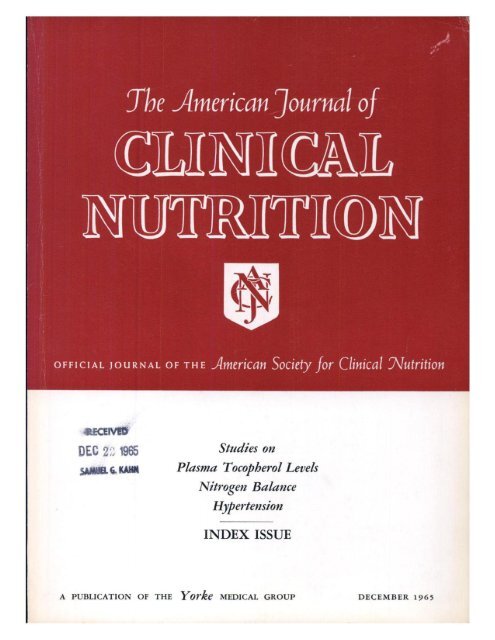肠道菌群可能改变膳食多酚摄入量和循环马尿酸水平之间的关系:来自中国一项为期一年的纵向研究的结果。
IF 6.5
1区 医学
Q1 NUTRITION & DIETETICS
引用次数: 0
摘要
背景:马尿酸(HA)是一种宿主-微生物共代谢产物,通常来源于肠道微生物对食物多酚的分解代谢。目的:我们研究了膳食多酚和肠道微生物群对循环HA水平的潜在相互作用,并研究了血清HA浓度与心脏代谢危险标志物之间的关系。方法:采用液相色谱-串联质谱法和16S核糖体RNA测序,对754名社区居民进行为期1年的血清HA及其前体[苯甲酸(BA)]和粪便微生物群测定。饮食、血压、血糖、血脂测量2次,间隔1年。1年后测量动脉硬度[以肱-踝脉搏波速度(baPWV)和踝-肱指数表示]和肝脏脂肪堆积[以控制衰减参数(CAP)表示]。结果:我们鉴定出27个微生物属,其相对丰度与血清HA浓度呈正相关(pfdr相互作用=0.03)。饮食中摄入较多儿茶素和绿原酸的参与者甘油三酯较低(百分比变化= -5.9%)。结论:预测循环HA水平的肠道微生物属可能改变了饮食多酚摄入量与循环HA水平之间的关系,血清HA浓度升高与多种心脏代谢危险标志物有利相关。本文章由计算机程序翻译,如有差异,请以英文原文为准。
Gut microbiota may modify the association between dietary polyphenol intake and serum concentrations of hippuric acid: results from a 1-year longitudinal study in China
Background
Hippuric acid (HA), a host-microbe cometabolite, normally derives from gut microbial catabolism of dietary polyphenols.
Objectives
We investigated the potential interplay between dietary polyphenols and gut microbiota on circulating HA concentrations and examined the associations between serum concentrations of HA and cardiometabolic risk markers.
Methods
In a 1-y cohort of 754 community-dwelling adults, serum HA and its precursor [benzoic acid (BA)], and fecal microbiota were assayed using liquid chromatography-tandem mass spectrometry and 16S ribosomal RNA sequencing, respectively. Diet, blood pressure, blood glucose, and lipid concentrations were measured twice, 1 y apart. Arterial stiffness [indicated by brachial-ankle pulse wave velocity (baPWV) and ankle-brachial index] and liver fat accumulation [indicated by controlled attenuation parameter (CAP)] were measured after 1 y.
Results
We identified 27 microbial genera whose relative abundance was positively associated with serum HA concentrations (PFDR < 0.05) and constructed a microbial score to reflect the overall HA-producing potential. In multivariate-adjusted linear models, dietary intake of catechins and chlorogenic acids was positively associated with serum HA concentrations among participants with a higher microbial score (β = 0.26, P = 0.03) but not among those with a lower score (β = −0.13, P = 0.30, Pinteraction = 0.03). Participants with higher intake of dietary catechins and chlorogenic acids had lower triglyceride concentrations (Percentage change = −5.9%, P < 0.05). Each 1 μmol/L increase in serum HA, but not in BA, was associated with 5.7%, 1.5%, 1.7%, 1.7%, and 1.7% decrease in triglyceride, systolic blood pressure, diastolic blood pressure, baPWV, and CAP, respectively (all P < 0.05).
Conclusions
The gut microbial genera that predicted circulating HA concentrations might modify the association between dietary polyphenol intake and circulating HA concentrations, and elevated serum HA concentrations are favorably associated with multiple cardiometabolic risk markers.
求助全文
通过发布文献求助,成功后即可免费获取论文全文。
去求助
来源期刊
CiteScore
12.40
自引率
4.20%
发文量
332
审稿时长
38 days
期刊介绍:
American Journal of Clinical Nutrition is recognized as the most highly rated peer-reviewed, primary research journal in nutrition and dietetics.It focuses on publishing the latest research on various topics in nutrition, including but not limited to obesity, vitamins and minerals, nutrition and disease, and energy metabolism.
Purpose:
The purpose of AJCN is to:
Publish original research studies relevant to human and clinical nutrition.
Consider well-controlled clinical studies describing scientific mechanisms, efficacy, and safety of dietary interventions in the context of disease prevention or health benefits.
Encourage public health and epidemiologic studies relevant to human nutrition.
Promote innovative investigations of nutritional questions employing epigenetic, genomic, proteomic, and metabolomic approaches.
Include solicited editorials, book reviews, solicited or unsolicited review articles, invited controversy position papers, and letters to the Editor related to prior AJCN articles.
Peer Review Process:
All submitted material with scientific content undergoes peer review by the Editors or their designees before acceptance for publication.

 求助内容:
求助内容: 应助结果提醒方式:
应助结果提醒方式:


